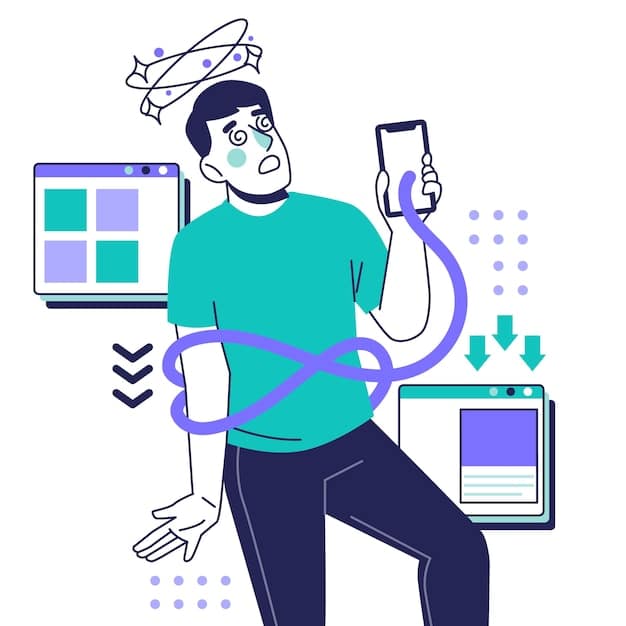Don’t Make These Common Customer Experience Mistakes: A Checklist for Avoiding Costly Errors

Don’t Make These Common Customer Experience Mistakes: A Checklist for Avoiding Costly Errors provides a clear roadmap for businesses to enhance customer satisfaction, loyalty, and ultimately, profitability by identifying and rectifying key CX pitfalls.
In today’s competitive market, customer experience (CX) reigns supreme. A positive CX fosters loyalty, boosts brand reputation, and drives revenue. Conversely, a negative CX can lead to customer churn, negative reviews, and a damaged bottom line. To help you navigate this crucial landscape, we’ve compiled a checklist of don’t make these common customer experience mistakes: a checklist for avoiding costly errors.
This article will guide you through identifying and rectifying prevalent CX pitfalls, ensuring your business delivers exceptional experiences that keeps customers coming back for more. By understanding and addressing these potential issues, you can transform your CX from a liability into a powerful asset. Let’s dive into the essential items to check to don’t make these common customer experience mistakes: a checklist for avoiding costly errors.
Understanding the Importance of Customer Experience and Costly CX Mistakes
Customer experience (CX) encompasses every interaction a customer has with your business, from initial awareness to post-purchase support. A positive CX creates loyal advocates, while a negative experience can quickly drive customers away. Recognizing the significance of CX and the potential pitfalls is the first step in building a customer-centric organization. It’s critical to don’t make these common customer experience mistakes: a checklist for avoiding costly errors, and understanding ways that will save you both in the long run.
Failing to prioritize CX can lead to various costly mistakes, including customer churn, negative reviews, and decreased revenue. These mistakes often stem from a lack of understanding of customer needs, poor communication, and inefficient processes. The good news is that these errors are often preventable with the right strategies and focus.
The Ripple Effect of Poor Customer Experience
A negative customer experience doesn’t just affect one customer; it can trigger a ripple effect that impacts your business in several ways:
- Customer Churn: Dissatisfied customers are likely to switch to competitors.
- Negative Reviews: Unhappy customers often share their experiences online, damaging your brand’s reputation.
- Decreased Revenue: Customer churn and negative reviews directly impact sales and profitability.
- Decreased Employee Morale: Employees become frustrated and disheartened when they lack the proper tools to improve CX.

Therefore, understanding and preventing common CX mistakes is not merely a best practice but a business imperative. Avoiding don’t make these common customer experience mistakes: a checklist for avoiding costly errors can substantially impact your companies financial success.
Ignoring Customer Feedback: A Critical CX Mistake
One of the most common and damaging customer experience mistakes is ignoring customer feedback. Customers provide valuable insights into their experiences with your business, and failing to listen to this feedback means missing out on opportunities to improve and innovate. To thoroughly don’t make these common customer experience mistakes: a checklist for avoiding costly errors you need to hear from the voices in the field.
Collecting customer feedback is only half the battle; you must also analyze and act on it. This means implementing systems for gathering feedback through various channels, such as surveys, reviews, and social media, and then using this data to identify areas for improvement.
How to Effectively Collect and Utilize Customer Feedback
To leverage customer feedback effectively, consider the following steps:
- Implement Multiple Feedback Channels: Offer a variety of ways for customers to share their experiences, including surveys, email, social media, and in-app feedback forms.
- Analyze Feedback Data: Use tools to analyze feedback data for common themes and pain points.
- Act on Feedback: Implement changes based on customer feedback and communicate these changes to customers to show that their voices are heard.
By actively listening to and acting on customer feedback, you can demonstrate that their opinions matter and create a more positive experience, addressing key elements to don’t make these common customer experience mistakes: a checklist for avoiding costly errors.
Lack of Personalization: A Major Customer Experience Oversight
In today’s world, customers expect personalized experiences tailored to their individual needs and preferences. A lack of personalization is a major oversight that can lead to customer dissatisfaction and churn. When customers feel like they are just another number, they’re less likely to stay loyal. The ability to personalize is a needed trait to don’t make these common customer experience mistakes: a checklist for avoiding costly errors.
Personalization goes beyond simply using a customer’s name in an email. It involves understanding their past interactions, preferences, and needs, and then using this data to provide relevant and valuable experiences. This can include personalized product recommendations, targeted marketing messages, and customized customer service interactions.
Strategies for Effective Personalization
To implement effective personalization strategies, consider the following approaches:
- Collect Customer Data: Gather data on customer demographics, preferences, purchase history, and interactions across all channels.
- Segment Your Audience: Divide your customer base into segments based on shared characteristics and behaviors.
- Personalize Communications: Tailor your marketing messages, product recommendations, and customer service interactions to each segment or individual customer.
By investing in personalization, you can show customers that you value them as individuals and create more meaningful and engaging experiences, and you can avoid don’t make these common customer experience mistakes: a checklist for avoiding costly errors.
Ignoring Mobile Optimization: A Critical Flaw in Customer Experience
In an increasingly mobile-first world, ignoring mobile optimization is a critical flaw in customer experience. Many customers primarily interact with businesses through their smartphones, and if your website or app is not mobile-friendly, you’re likely to lose them. Mobile optimization for your business is essential to don’t make these common customer experience mistakes: a checklist for avoiding costly errors.
Mobile optimization involves ensuring that your website and app are easy to use on mobile devices, with responsive design, fast loading times, and intuitive navigation. It also includes ensuring that your mobile channels provide a seamless and consistent experience across all touchpoints.

Best Practices for Mobile Optimization
To optimize your mobile customer experience, consider these best practices:
- Use Responsive Design: Ensure your website adapts to different screen sizes and devices.
- Optimize Loading Times: Reduce image sizes and streamline code to improve loading times on mobile devices.
- Simplify Navigation: Make it easy for mobile users to find what they’re looking for with clear and intuitive navigation.
- Test on Different Devices: Regularly test your website and app on different mobile devices to ensure a consistent experience.
By prioritizing mobile optimization, you can provide a better experience for your mobile customers and capture a larger share of the mobile market, and don’t make these common customer experience mistakes: a checklist for avoiding costly errors.
Poor Customer Service: A Sure Way to Damage the Customer Experience
Poor customer service is a sure way to damage the customer experience. Customers expect prompt, helpful, and friendly assistance when they have questions or issues. Failing to provide excellent customer service can lead to frustration, dissatisfaction, and customer churn. Customer service is one of the keys to don’t make these common customer experience mistakes: a checklist for avoiding costly errors.
Excellent customer service involves training your staff to be knowledgeable, empathetic, and responsive. It also involves providing multiple channels for customers to reach out for support, such as phone, email, chat, and social media.
Strategies for Improving Customer Service
To enhance your customer service, consider these strategies:
- Train Your Staff: Provide comprehensive training to ensure your staff can handle customer inquiries effectively and empathetically.
- Offer Multiple Support Channels: Give customers options for reaching out for support based on their preferences.
- Respond Quickly: Respond to customer inquiries promptly, whether through phone, email, or social media.
- Empower Your Staff: Empower your staff to resolve customer issues independently, without unnecessary delays or red tape.
By investing in excellent customer service, you can turn potential problems into opportunities to strengthen customer relationships and don’t make these common customer experience mistakes: a checklist for avoiding costly errors.
Neglecting to Measure Customer Experience: A Missed Opportunity for Improvement
Finally, neglecting to measure customer experience is a missed opportunity for improvement. Without measuring CX, you can’t know what’s working, what’s not, and where to focus your efforts. Measuring CX enables your company to don’t make these common customer experience mistakes: a checklist for avoiding costly errors.
Measuring CX involves tracking key metrics such as customer satisfaction (CSAT), Net Promoter Score (NPS), and Customer Effort Score (CES). It also involves analyzing customer feedback and identifying areas for improvement.
Key Metrics for Measuring Customer Experience
To measure your customer experience effectively, consider tracking these key metrics:
- Customer Satisfaction (CSAT): Measure customer satisfaction with specific interactions or touchpoints using surveys or feedback forms.
- Net Promoter Score (NPS): Measure customer loyalty and advocacy by asking customers how likely they are to recommend your business to others.
- Customer Effort Score (CES): Measure the ease of doing business with your company by asking customers how much effort it took to resolve their issue.
By keeping up with measurements of Customer Experience, you can track them overtime. This allows adjustments and corrections to don’t make these common customer experience mistakes: a checklist for avoiding costly errors.
| Key Aspect | Brief Description |
|---|---|
| 👂 Listening to Feedback | Collecting and acting on customer reviews to enhance services. |
| 📲 Mobile Optimization | Ensuring a seamless experience across all mobile devices. |
| 🤝 Customer Service | Providing prompt and effective support to address customer needs. |
| 📊 Measuring CX | Using metrics like CSAT and NPS to track and improve customer experience. |
Frequently Asked Questions
Common mistakes include ignoring customer feedback, lack of personalization, poor mobile optimization, inadequate customer service, and failing to measure the customer experience. Addressing these issues can significantly improve customer satisfaction.
Ignoring feedback can lead to missed opportunities for improvement, increased customer churn, and a damaged brand reputation. It’s essential to listen to and act on customer insights to drive positive change.
Personalization makes customers feel valued and understood. By tailoring experiences to individual preferences and needs, businesses can build stronger relationships and foster loyalty.
Poor mobile optimization can lead to frustration and dissatisfaction, as many customers primarily interact with businesses through their smartphones. A mobile-friendly website or app is crucial for capturing a larger share of the mobile market.
Key metrics include Customer Satisfaction (CSAT), Net Promoter Score (NPS), and Customer Effort Score (CES). Tracking these metrics helps businesses identify areas for improvement and measure the effectiveness of their CX initiatives.
Conclusion
By avoiding don’t make these common customer experience mistakes: a checklist for avoiding costly errors, businesses can create exceptional experiences that foster customer loyalty and improve profitability. Prioritizing customer feedback, personalization, mobile optimization, customer service, and CX measurement are essential for success.
Transforming your CX strategy involves commitment, vision, and a customer-centric mindset. By ensuring you don’t make these common customer experience mistakes: a checklist for avoiding costly errors, you can establish a competitive advantage in the market. Start today by assessing your current CX practices and implementing the strategies outlined in this guide.





